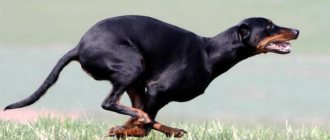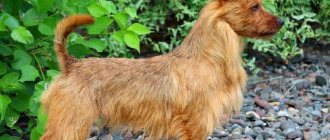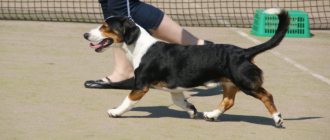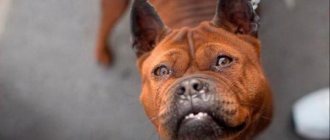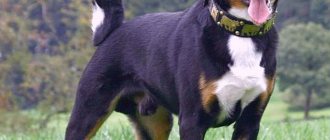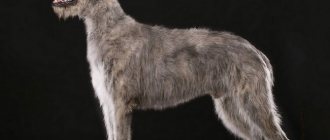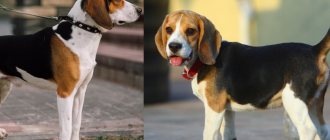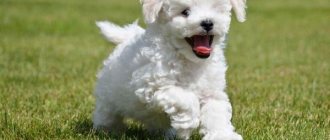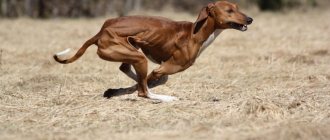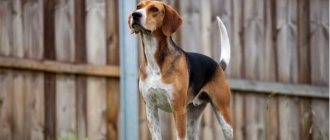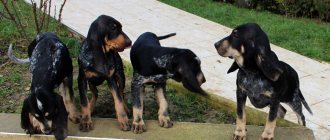Origin story
The breed , which has the same traits as the modern Basset Hound , was first depicted in 16th century France. Experts say that the picture shows the closest ancestor of the Basset Hound. But references to such dogs are found in earlier written sources. They were called "bassets", artesian-Norman hounds. Distinctive features are easily visible: powerful body and short legs. The squat silhouette and short limbs are the result of a mutation fixed by breeders.
The task of basset hounds is burrow hunting. Short legs and stockiness allowed the dogs to chase the animal into its home without any problems, and the powerful body gave them a good chance of dealing with the prey on their own. Hares and rabbits, searching for squirrels were also the duties of this breed.
In the 17th century, French breeders began breeding basset dogs seriously - it turned out that short-legged dogs were capable of hunting not only badgers, rabbits and foxes, but also pheasants. The non-standard hounds were unable to keep up with the horse, so the hunt was on foot. But the basset hounds were great at chasing over rough terrain: thickets, dead wood, and bushes did not pose a problem for dogs of this breed.
There was no talk of cooperation between breeders in those days, so by the beginning of the 18th century, at least 12 varieties of basset dogs could be found. Who knows what the future fate of the breed would have been like if not for the British.
During the French Revolution, Bassets were destroyed with all the bitterness of the poor. The revolutionaries considered this breed a symbol of the hated aristocracy. After the situation stabilized, breeders were able to find only purebred Basset Hounds of the Normandy and Artesian varieties.
Bassets appeared at shows under the name "short-legged hunting dog." British breeders present at the show became interested in the breed and took several dogs to the British Isles.
Local breeders are known for their tendency to "nationalize" existing dog breeds. Bassets did not suffer the same fate: English breeders quickly crossed them with Bloodhounds . The result is long ears, folded skin and increased bulk. The resulting dogs were called Basset Hounds and, without hesitation, were presented as a new breed at the Paris Exhibition of 1863.
Despite the huge period of time when the breed developed in France, it is registered as English. The name consists of two words - “bass” (low) and “hound” (hound). Low hound.
In 1883, the first club for fans of the breed was opened. In 1887, the standard was adopted and received international recognition. At the end of the 19th century, basset hounds conquered the New World, where local breeders did not fail to cross French “short-legged hunting dogs” and British basset hounds. The result was the birth of the American Basset Hound: in 1933, its standard was approved by the American Kennel Club. In Russia, breeding representatives of the breed appeared only in the 1970s.
The charm of basset hounds captivated the English Queen Alexandra and the American President George Washington.
Third section: related breeds
The exact origin of related breeds has not been established. Despite this, their appearance, character and working qualities are the same as other hound breeds.
Dalmatian
The first mentions of spotted Dalmatians date back to the 16th-17th centuries. Their images adorn churches and monasteries, as well as portraits of influential nobles.
In the 18th century, English breeders began breeding Dalmatians, noting the dogs’ amazing ability to run for a long time tirelessly, along with a horse-drawn carriage. For this reason, dogs began to be involved in guarding carriages and hunting game.
Dalmatians are prone to deafness. Hearing problems occur in 12% of newborn puppies.
“ The most interesting thing about the Dalmatian
Rhodesian Ridgeback
The Ridgeback is the only South African hound to achieve international recognition. Until the 19th century, it was used to protect livestock, and only after that the European nobility, who sailed to Africa from the Old World, became interested in it.
Gradually, jackal-like dogs with an oblong comb of wool on their backs were retrained as lion beaters. During breeding work, enthusiasts added genes for mastiffs, Great Danes, pointers, terriers, retrievers and bloodhounds, increasing their initial strength and speed.
Do you like the article? 0
Basset Hound: breed description and characteristics
The Basset Hound dog breed has a specific appearance; it is problematic to confuse it with other dogs. A powerful body with folds, short but strong legs, long ears and eyes filled with universal sadness - all this is a Basset Hound.
Basset Hound breed standard
- Head : Dome-shaped, with a distinct occiput. The muzzle is massive, with a smooth transition from the forehead. There are wrinkles under the eyes and at the eyebrows.
- Eyes : shallow-set, oval-shaped, dark brown in color. For Basset Hounds with a light coat color, brown is acceptable. Yellow and light brown eyes are not allowed by the standard.
- Nose : with wide open nostrils, black lobe. For light-colored Bassets, brown and liver colors are acceptable.
- Ears : long, narrow, hanging, set low, with a thin, velvety ear flap.
- Jaws : With a scissor bite, the drooping upper lip covers the lower jaw (jowls).
- Neck : Quite long, thick, with a pronounced bend above and dewlap below.
- Body : long, strong, with developed muscles. The back is wide, withers and croup are located on the same line.
- Chest : developed, wide, deep, but not too deep.
- Belly : quite tucked, does not interfere with movement.
- Limbs : forelimbs – short, muscular, with powerful bones and shoulder blades set at an angle of 45 degrees, with folds in the lower part. The hind legs have strong hips, strong hocks, and short metatarsals. The paws are large, arched, with large pads.
- Tail : long, strong, with a slight bend - saber-shaped, tapering towards the tip. Raised up while driving.
- Coat : short, dense, without fringes.
Dimensions and weight
Height at withers : from 33 to 38 centimeters.
Weight : from 18 to 29 kilograms.
Popular Basset Hound Colors
The most common colors are:
- tricolor - black, white and red;
- bicolor - white and red.
The standard allows for any hound-specific colors.
Division into groups
There are several classifications of dogs of this species, depending on the criterion that underlies the division.
For example, based on the number of simultaneously working animals, they are distinguished:
- Hounds working one at a time (example: Laufhund);
- Dogs performing in pairs or in a pack (example: Russian hounds, beagles, etc.).
By type of sequence there are:
- Dogs for complete (mountain hunting). Here the animals follow a pack of horses, and when they are brought close to the habitat of the prey (wolf, fox, etc.), they begin searching for it and racing together. The process stops when the prey reaches the gun or a group of greyhounds. A typical example is the English Foxhound.
- Dogs for hunting on foot. This includes dogs capable of working alone or with a partner. The dog must search for prey by following the scent, being far from the owner, follow it for a long time, up to several days, read the confused tracks, and notify the owner of his location with his voice. Examples: Basset Hound, Breton Griffon and Nivernes Griffon.
- Dogs for working on the blood trail . Hounds of this group are used to track wounded animals, usually ungulates. The dog must remain silent while following the blood trail; its voice is given only when it reaches its prey. Examples: Bloodhound, Estonian and Bavarian hounds, Poitevin.
There are also Western, Eastern and Brutish types of hounds. Dogs of the first option are distinguished by rounded ears, a powerful blunt muzzle, and short hair (for example, bloodhounds).
- Orientals have a flat wolf-type nose, a medium-length tail, narrow ears with a sharp angle, a muzzle and legs with short hair, and they also lack dewclaws (for example, Russian and Polish hounds).
- The busty type does not have a high running speed, but they are very durable. Dogs of this species are characterized by a short, rounded skull and smoothly rounded ears (for example, the Niverney griffon, Otterhound).
The most popular classification of this type is based on size. There are small, medium and large species.
Kinds
Experts distinguish four types of Basset Hounds:
- The Artesian-Normandy Basset Hound is an excellent hunter of burrowing animals, capable of working in a pack or individually, and is very difficult to train. In appearance, one can note a very massive skull, large oval-shaped eyes, an elongated body, short crooked legs and smooth, dense fur.
- The Vendeen Griffon Basset Hound is an excellent choice for apartment living. A calm but active dog with increased friendliness. An elongated, refined head, round eyes of medium size, a very developed body with a wide chest, powerful, wide-standing paws.
- The Blue Gascony Basset Hound is a brave and inquisitive animal, stubborn, but absolutely devoted to its owner. He quickly learns the rules of behavior and does not cause unnecessary trouble in caring for him.
- The red Breton Basset Hound is a very affectionate dog with people, loves children, and does not require special care. In hunting it is used as a beater of medium-sized game. The head is long, narrowed, the eyes are large, the ears are narrow, the body is tightly knit, and the legs are very powerful.
Basset Hound character and habits
The large sad eyes of the basset seem to speak of universal melancholy, wisdom and phlegm.
But no. In everyday life, the Basset Hound is a very proud and proud dog, unforgiving of insults and insults, loving comfort and convenience, and not hesitating to use tricks and tricks. In relation to household members, the dog is friendly, sociable, loving... until they step on a sore spot . Raising your voice, coercion, decreasing comfort - all these are reasons for terrible revenge from a dog that has been wounded in its best feelings.
Owners can recognize the resentment of a basset hound by foul-smelling piles and puddles in the most inappropriate places, or by things and interior items that have suddenly lost their strength.
It will not be possible to re-educate or accustom a Basset Hound to Spartan conditions. Rather, the dog will train the owner to provide him with the best. Sleep on a soft bed, eat delicious food, place only what the Basset himself has chosen. And if the owner is not happy with something, then this is not the problem of the best dog in the world.
Loneliness is not something Basset Hounds crave. Several hours without communication is a reason for terrible revenge. Those same piles, puddles... You can be absolutely sure: even if a Basset is forbidden to climb onto the marital bed, if left alone, he will certainly, on principle, take a nap there for an hour or two.
Strangers need not fear aggression from the Basset Hound. Like all hunting breeds, he does not see humans as enemies. In this regard, a basset hound will also not work as a guard.
It's more complicated with animals. Typically, hunting breeds see other animals solely as game that needs to be caught - with all that comes with it. But Bassets do not have the most serious form of dependence on the hunting instinct. They are quite capable of getting along with other dogs.
With cats and rodents everything is much worse. But, if another animal was already in the house when the little basset hound arrived, most likely there will be no problem. In adulthood, a lot depends on the first acquaintance. The owner must make a lot of effort so that the animals do not become afraid of each other and do not start hostility from the first minutes.
Basset hounds do not like to start quarrels with other dogs while walking. But a cat looming nearby is quite a worthy reason to go hunting.
Attitude towards children
Basset Hounds are always sweet with children. Communication with “human puppies” gives them a lot of pleasure. Of course, until the moment when the child crosses the boundaries of the dog’s comfort. As soon as this happens, the basset will prefer to hide in the far corner, writing down grievances. But aggression and bites from a basset hound cannot be expected, even if the child tramples his paws and pulls out his whiskers.
Pros and cons of the breed
You can admire Basset Hounds, you can dislike them, but the representatives of the breed do not leave anyone indifferent.
Pros:
- Possibility of apartment maintenance.
- Calm and friendly.
- Excellent relationship with children.
- Easy care.
- Bright appearance.
- Devotion.
- Excellent hearing and sense of smell.
Minuses:
- Selfishness and stubbornness.
- Tendency to gain excess weight.
- Predisposition to a number of diseases.
- Vengefulness.
- Intolerance of loneliness.
- Lots of drool.
- Specific smell.
- Barking and howling.
Choosing a puppy and its cost
It is impossible to buy a Swedish Dachshund Bracket puppy in Russia; in our country this breed is completely unclaimed . However, there are nurseries for breeding trees in the Scandinavian countries (Denmark, Sweden, Norway, Finland, etc.), as well as in Estonia and Lithuania. You should purchase a small pet through specialized hunting clubs, since most breeders are their members. The cost of a purebred puppy starts from 700 euros; adult working dogs are sold for much more.
Visually distinguishing a baby Drevera from other similar breeds (the same beagle) is extremely difficult; it is difficult for an uninitiated person to understand all the nuances. A guarantee of purebred will be the presence of appropriate documents (field diplomas and pedigrees of the parents, puppy card, etc.), as well as a mark in the groin (or ear) of the puppy, which must correspond to the entry in the breed book.
You can only buy a Drever puppy in Scandinavian countries.
Education and training
It is necessary to raise a baby basset hound from the very first day of his arrival in the house. Hunting breeds have problems with obedience. But these dogs follow the rules of behavior and prohibitions learned at an early age.
Place training, show a tray, a place for feeding, prohibit climbing on the owner's bed and chewing clothes - all these are important aspects of raising a puppy.
Socialization is an important component of a dog's development. With the help of the owner, the Basset Hound gets acquainted with the surrounding world , the living creatures that inhabit it, and learns to react correctly to them and to various events. Along the way, contact is established between the dog and the owner. Socialization largely determines how a dog will grow up.
Even before the first walks, it is necessary to accustom the basset to a collar and leash, learn the simplest commands: “Come to me”, “Place”, “Near”, “No”. This will simplify communication with the animal and ensure control over it while walking.
Often representatives of the breed become stubborn, refusing to follow commands. There is no need to shout, get angry, or use physical force. This will only lead to resentment and terrible revenge from the offended dog. You need to take a break and continue studying.
It is important to remember that the workout should not last longer than 10 minutes. This time is enough for the basset to get bored. After 10 minutes a break is required. A positive motivation is the basset hound’s favorite treat: representatives of the breed love to eat. The main thing is not to overdo it.
If we talk about professional courses, the following would be useful:
- OKD (general training course), which teaches the basics of obedience;
- UGS (smart city dog).
But the protective guard service (PSS) is beyond the power of basset hounds; they do not experience aggression towards people and cannot become either defenders or watchmen.
Medium breeds of hounds
The group is compact in size with an energetic and fearless character. Many of them are suitable for city apartments, with a mandatory vigorous walking. They are quite peaceful, for the most part they can live in families with animals and children.
Norwegian Hound (Dunker)
It took shape at the beginning of the 19th century in Norway. The goal is to track the hare. Capable of finding prey, chasing it away and bringing it to its owner. Can work in hot and cold weather, in the snow. It is distinguished by persistent pursuit at not very high speeds.
Height – 47-55 cm at the withers, weight – 16-25 kg. The body is slightly elongated, the legs are high and muscular. The Dunker's ears are long, soft, rounded, and hang down. The coat is short, marbled blue and tan or tri-colored.
- This is a balanced and patient dog, rarely gets into fights, and is easy to train. However, she is somewhat independent in making decisions.
- Keeping it in a country house is recommended, with mandatory physical activity.
Porcelain hound (porselen or noble royal)
A rare breed, bred in France in the 15th century . It was almost destroyed during the French Revolution, but was later restored. It got its name due to its color and graceful appearance. It often walks in a pack and is used to herd hare, roe deer, and sometimes wild boar. May follow the trail of a wounded animal.
The height of the dogs is 53-58 cm at the withers, weight is 26-30 kg. Porselen has a proportional build, is elegant, and long-legged. The skull is broad, slightly elongated, and the ears have a pointed edge. The tail is thick, whip-like. The color is white, with red spots or specks.
At home he is a calm, kind, friendly dog, but on the hunt he is the embodiment of excitement and impulsiveness. Not for apartment conditions.
Harrier
Harriers are the basis of many breeds; England is considered its homeland. Selection was carried out to obtain dogs for riding hares, foxes, and sometimes wild boars. It is distinguished by its high-speed running, including over rough and mountainous terrain, its temperament and willfulness.
Height – 46-53 cm, body weight – 20-27 kg. The body is strong and stocky, the muzzle is elongated, pointed, with a flat skull. The ears are short in length and resemble the letter V. The tail is thick and raised up. The length of the coat is medium, it is not soft. Three-colored colors are more common, but all those characteristic of the species are acceptable. Requires persistent and long-term training.
- Suitable as a family dog with the obligatory energetic walking, trips to nature, as well as jogging behind a bicycle or horse.
Estonian hound
A young breed, formed in the mid-20th century, when in Estonia there was a ban on hunting with dogs over 45 cm. Not officially registered by the FCI. Used for tracking hares, rabbits, foxes, and other small animals. Persistent, can keep a trace for up to 3 days.
The height of the animal is 42-52 cm, weight is 10-25 kg. Visually, Estonians resemble beagles. The body is stretched, the head is rounded, with an elongated muzzle. The ears are quite long, their tips are rounded. The height of the coat is small and hard. Black and piebald, less often brown or crimson piebald.
- Dogs are affectionate, balanced, love children, and tolerant of other pets. Apartment housing is possible if there is high physical activity, but living in a house with a spacious enclosure is better suited.
Swiss Laufhund
One of the oldest breeds. Similar dogs existed in Ancient Egypt, then with Roman legionnaires they found their way to the Alps. They are the progenitor of many hounds. Bred for hunting hare and fox. Can also be used for baiting wild boar. They work well on the blood trail. Nowadays they are more often used in solo hunting on foot.
There are short-legged and long-legged varieties. The height at the withers of the former is 32-41 cm, weight – 14-18 kg, the latter – 46-59 cm and 16-23 kg.
- The Laufhund's body is elongated, its head is stretched, graceful, with a double chin. The ears are long and cone-shaped. The coat is short, harsh or smooth. The color is white, with large red or yellow spots.
- Laufhunds are distinguished by their absolute fearlessness, loyalty, and very high intelligence. They are wary of strangers and do not get along well with other animals. Not suitable for living in apartment conditions.
Hunting with Basset
In Russia, basset hounds are rarely used during hunting; most often, representatives of the breed act as a companion.
But in European countries and the States, hunters often use the services of basset hounds. Basset hounds are very passionate when hunting; during the pursuit they often do not pay attention to the owner’s commands. They don’t even need additional training: when they see an animal, they immediately rush after it, barking loudly. A basset can chase an animal for several hours to bring it under the hunter's shot. The Basset Hound's running speed is low, but it has enough endurance. Hare, squirrel, pheasant are the main hunting targets of this breed.
The Basset Hound works excellently on the blood trail, finding and chasing wounded animals. Excellent sense of smell and hearing are the distinctive features of the breed.
Basset hounds also perform well when hunting large animals, such as wild boar. They make excellent hunting partners with spaniels. Without hesitation, they take a fox out of a hole in the company of a dachshund. They participate in both open and field hunting.
Distinctive features of hounds
Hounds, along with greyhounds and pointers, belong to the hunting group of dogs. Unlike the latter, dogs of this species work to drive the animal under the hunter’s gun, and can travel enormous distances while tracking it down.
Greyhounds are determined to catch only visible prey, bait it, develop great speed, but over a short distance. The cops track the target, usually a bird, and take a special stance that gives a signal to the owner about its location, and then drive out the find under fire.
All groups of hounds have some common external characteristics, such as:
- Free-hanging ears of varying lengths, with tips pointing down;
- Straight bridge of the nose;
- Black lobe;
- Lips tightly adjacent to the jaw (with rare exceptions);
- Large skull with a rounding at the junction with the neck;
- Smooth back;
- Volumetric breasts;
- Strong, muscular legs;
- Most often smooth, short hair, piebald, saddleback, wolf, merle or red-yellow.
In addition to similar external features, hounds also have other common characteristics. They are resilient and persistent, and can pursue their goal for many hours. Thanks to their keen sense of smell and high speed of movement, they are excellent at tracking down prey. The loud, ringing bark of all representatives of the species helps the owner understand where the animal and pet are.
Hounds are human-oriented, submissive, have the ability to quickly learn, and have an agility that allows them to control the animal well during the hunt. They are also excellent for group work, quickly establish contact with other individuals in the pack, harmoniously chase the animal, change formation together, walk in a bow, turn around, and take the necessary positions.
All hounds have a tendency to run away.
Care and maintenance
Modern basset dogs are not well suited to living outdoors, so enclosures and kennels are not a suitable place for them. The Basset Hound needs to live in a house or apartment. Caring for Basset Hounds is not difficult. A soft bed, a stand with adjustable height of bowls, toys - a standard set for a domestic dog.
But there are also features:
- The Basset will most likely decide on its own place to sleep and rest. Persuading him to change places is problematic.
- The basset's paws are quite fragile at an early age - up to about a year. It is necessary to exclude jumping even from the sofa, and climb stairs with a puppy in your arms.
Hygiene
- be brushed twice a week. This includes tidying up the fur, massage, and stimulating blood circulation. During molting - in spring and autumn - combing becomes a daily procedure. Basset hounds do not need a haircut.
- Water treatments - twice a month. Basset Hounds have a specific smell from their fur, and their short legs make it difficult to keep them clean during walks. When washing, only special shampoo is used so as not to harm the Basset's skin and coat.
- Ears require special attention - both when bathing, when you need to make sure that no water gets into them, and when cleaning. Ventilation of the ears in this breed is poor, so inflammation is not uncommon. Ear examinations should be done weekly, as should cleaning of excess wax. A cotton pad and veterinary lotion will help.
- The eyes are also a vulnerable spot for the basset. They are prone to conjunctivitis and excessive tearing. Regular rinsing with chamomile infusion or veterinary lotion will help with prevention.
- Folds in the skin are another “sore point” for the Basset. After each meal and walk, it is necessary to wipe the folds on the animal’s face so that food debris and dirt do not accumulate in them. In combination with excessive salivation, a favorable environment is created for pathogenic bacteria.
- Nails must be trimmed as they grow using a nail clipper.
Walk
The recommended time for walking Basset Hounds is twice a day for an hour or more. During a walk, the basset hound transforms from a couch snob into a gambling hunter.
It is better not to let your Basset Hound off the leash in public places: chasing a cat or bird can lead him far. But free range is also necessary for representatives of the breed.
While walking, you should not overload your basset with marathons or speed running. Tagging in a limited space and playing with a ball are much better suited. Walking on a leash should not be exhausting for the dog and the owner, but a “snail” pace is not suitable either.
Proper camouflage is one of the traits of a hunter, so the basset willingly rolls around in mud, carrion, and waste products. The owner should be more careful while walking.
To protect the dog from the effects of camouflage and road dirt, many owners use overalls. They serve to protect the dog from pollution, not from weather conditions. Dense wool with a thick undercoat provides excellent protection from frost and heat.
Feeding
The Basset Hound is one of those breeds that knows no limits. He is ready to eat, eat and eat, so control over the number of meals, diet, portion size falls entirely on the owner.
The Basset is quite happy with dry food, but not less than super premium food. Such food contains everything necessary for health, good quality of life, and development of a representative of the breed. The serving size is indicated on the package.
An adult Basset Hound eats twice a day. Sad eyes and requests for more will have to be reluctantly refused.
Basset hounds are prone to obesity , which leads to a huge number of health problems, so no feeding, no increased portions - the basset simply cannot get enough.
With natural feeding, the Basset Hound diet includes:
- lean meat;
- low-fat fermented milk products;
- sea fish fillet;
- vegetables and fruits;
- cereals
Strictly prohibited:
- fat meat;
- marinades and pickles;
- smoked meats and sausages;
- sweet and flour dishes;
- chocolate;
- canned food;
- River fish;
- legumes
With a natural diet, it is necessary to periodically add vitamin and mineral complexes to food - the necessary things are simply not found in ordinary foods. Mixing natural feeding and dry food is strictly prohibited.
Health and how long does the Basset Hound live?
Bassets have a fairly strong immune system. Basset hound diseases are caused by the specific structure of this animal. Basset Hounds are susceptible to the following problems:
- pelvic dysplasia;
- problems with joints and spine;
- eye diseases;
- otitis;
- volvulus;
- obesity;
- cardiovascular problems;
- allergy.
Basset hounds live on average from 10 to 12 years. Good care and proper maintenance can add several years to life expectancy.
Health
The Alpine Short-legged Hound is a healthy and long-lived breed.
Nutrition
The breed has no special nutritional requirements. Of course, a working dog should be given more energetic food.
care
Caring for the mountaineer is simple, just brush it with a comb from time to time, more often during the molting period.
